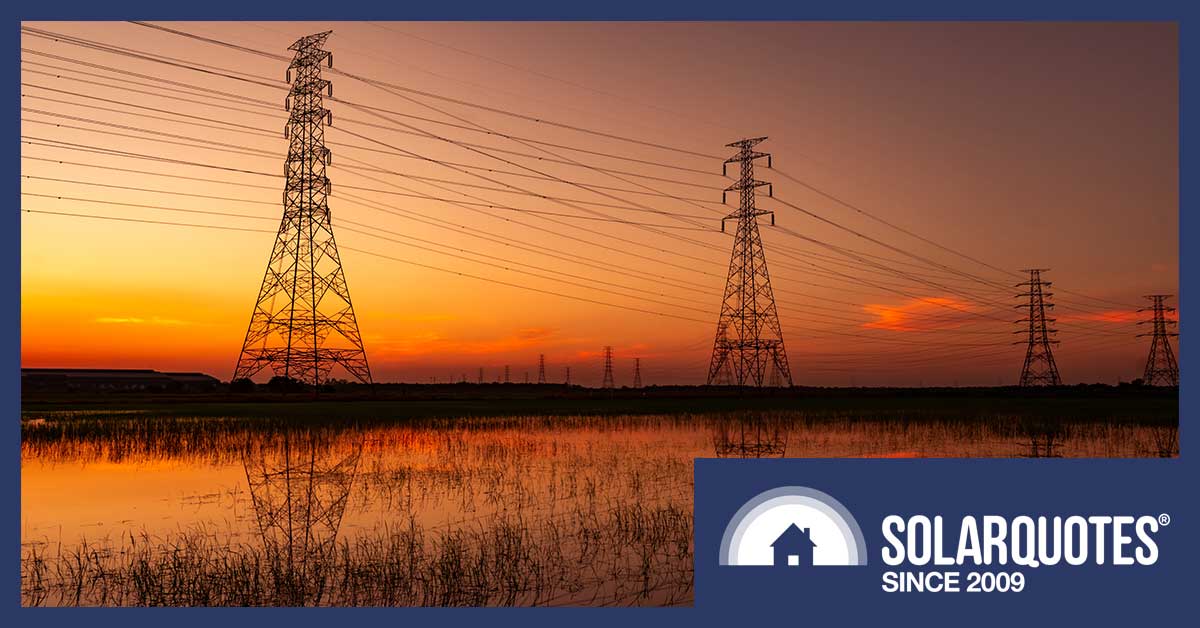
Long-distance transmission sends electrical energy from where it’s generated to where it’s used. If we had more of it, electricity prices would be lower, and the integration of solar and wind farms would be easier. Thanks to record low-interest rates, more of it is exactly what we’re going to get.
Not only will transmission capacity be increased between the five, already gridded together, eastern states — we may even get an undersea transmission cable linking the Northern Territory to Indonesia and Singapore. Most bizarre of all, the eastern states may be connected to the far distant land of Western Australia where they drink swan flavoured beer, and the sun hangs around in the sky for an average of two hours and 20 minutes after it has set in Sydney.
Existing Electricity Transmission
Large generators — whether solar farms, wind farms or pollution-spewing coal power stations — all have a location problem. Unlike rooftop solar, they’re not located where their power is used. The solution used is long aluminium cables to send the electricity where it’s required.
The 5 eastern states are already interconnected to varying degrees. This happened on the Pacific side due to the higher population density that has resulted from these states being habitable.
I’m not saying the Northern Territory and Western Australia aren’t habitable by humans, but I will say they’re not habitable by the Dutch. Not the sane ones, at least. Not unless there’s air conditioning.
Because the populated parts of the NT and WA are surrounded by inhospitable oceans of desert and/or channel country, they have their own separate grids; one main one and two or three itty bitty ones. It’s a very different situation from the Eastern States where sunshine falling on an Adelaide roof can contribute to keeping Townsville refrigerators running.
Here’s a map with a key that’s almost impossible to read, showing Australia’s existing high voltage transmission lines:
Interstate Electricity Transmission Is Relatively New
Australia’s first interstate transmission1 came about as part of the Snowy River Scheme that linked New South Wales and Victoria. But this providing clear evidence states could swap electricity without catching cooties, it was well over a decade before any other state tried it. Despite the electric connection they could easily have had, states were very reluctant to hook up. I know this sounds odd in these internet-connected days. Still, you have to remember, this is a country that decided every state should be free to express its individuality by picking whichever railway gauge best suited its mood and we ended up with 3 of them.2
Australia has traditionally had much less long-distance transmission than would have made sense in retrospect. This is despite the fact there was massive over-investment in grid infrastructure early last decade. This mis-investment was less about long-distance electricity transmission and more about beefing up grids to cope with an expected increase in electricity demand that never occurred. Instead, grid consumption slowly declined. Electricity prices shot up to pay for the extra infrastructure, which caused people to use even less electricity. It was pretty stupid.
I think we have learned maybe 3% of what we should have from that experience, so here’s hoping things go better with the new build-out of long-distance transmission.
Popularisation Of Transmission
Electricity transmission between states didn’t take off until a group of publicly minded naughty schoolboys formed a band to popularize the idea through music. Their songs included:
- It’s A Long Way To The Top Of A Power Pole.
- You Shook Me All Line Long.
- Electric Deeds Done Dirt Cheap.
Admittedly, they didn’t have any real success until their producer made them change the lyrics, but at least they stopped him from changing the name of their band — AC/DC.
Two Types Of Transmission: AC & DC
There are two types of long-distance electricity transmission:
- High Voltage Alternating Current (HVAC)
- High Voltage Direct Current (HVDC)
High Voltage Alternating Current (HVAC): The most commonly used electricity transmission method uses alternating current (AC). This involves electrons in a cable all rushing one way and then altering their direction and rush back the way they came. This happens 50 times a second in Australia and most other countries, but in a few places, it’s 60 times because variety is the spice of electrical equipment incompatibility.
HVAC has commonly been used ever since Thomas Edison lost the “war of the currents“. A failure that resulted in him dying with nothing but the love of his family and over $200 million in today’s money. Nikola Tesla, the genius who won the battle, had to make do with a nice hotel room and the love of a pigeon.
High Voltage Direct Current (HVDC): While Thomas Edison was on the wrong track when he backed DC current for homes and businesses, developments in High Voltage Direct Current really have nothing to do with what he was on about and doesn’t vindicate his DC desire in any way what-so-ever.
Direct Current (DC) travels in one direction in a loop. By using high voltages, it can allow long-distance transmission with minimal losses. This means it will be used for any extremely long-distance new transmission lines, such as Australia to Singapore or Australia to Australia if we ever connect WA to the Eastern States.
HVAC versus HVDC: With HVAC transmission the current is synchronized with the grid. This means the electrons all rush back and forth in the same direction at the same time. Because of this, adding additional HVAC transmission to a grid can strengthen it and prevent blackouts by helping keep distant grid regions synchronized. Unfortunately, if something goes wrong at one end of the electricity transmission line, it can potentially cause a blackout at the far end.
HVDC is unsynchronized. This means it only supplies energy and doesn’t directly contribute to the system strength of the grid. It also means problems can’t propagate. This is handy if we build an interconnector to Indonesia and Singapore, as we’d just piss each other off if problems could leap across the Java and Timor seas.
How Extra Transmission Lowers Electricity Prices
Long-distance electricity transmission reduces the cost of electricity in four main ways:
- Improved market efficiency
- Increased competition
- Shared ancillary services
- Integration of renewable generation
- Geographic dispersion and time-shifting.
Market Efficiency: If electricity is cheap in South Australia and expensive in NSW, consumers in the states can only benefit if there is available transmission capacity. More electricity transmission allows more low-cost energy to be sent where it’s needed most, reducing bottlenecks and lowering prices.
Competition: We’re supposed to be protected from price gouging by competition. But there aren’t enough electricity providers to prevent a large supplier using their market power to drive prices higher than they would otherwise be. More transmission allows more suppliers to contribute, increasing competition.
Ancillary Services: These support the electricity grid in a range of ways to keep it stable and prevent blackouts. Improved transmission can allow different regions to share some of these ancillary services and reduce their total cost.
Integrating Renewables: Wind and solar farms are relatively inexpensive to build these days — provided there’s existing transmission capacity available for them to use. More transmission allows more large scale renewable energy be integrated into the grid and supply most of the energy they generate, instead of being forced to curtail output when electricity transmission capacity is congested.
More renewable capacity helps keep electricity prices low, as wind and solar power have no fuel cost. While constructing solar and wind farms costs money, once they’re completed their operating costs are minimal compared to gas and coal power.
Geographic Dispersal: Imagine flat. Double it. That’s most of Australia. Being the least lumpy continent3 results in a lot of correlation between wind speeds in South Australia, New South Wales, Victoria, and Tasmania. But in northern Queensland, the wind does its own thing and can be blowing hard while there’s hardly a breeze in the rest of the country. It’s similar with solar; Some regions can be overcast while others have blazing sunshine. This geographical dispersion of variable renewable capacity allows for a more constant and reliable supply of energy from wind and solar power and is dependent on adequate electricity transmission capacity.
Time Shifting: This usually refers to peak demand occurring at different times, which allows additional transmission to reduce the cost of meeting demand during peaks. But I’m also going to use it to refer to the fact the sun rises and sets at different times depending on where you are in the country. While it varies according to the season, on average, the sun in Perth sets around 2 hours and 20 minutes after it sets in Sydney. This means an electricity transmission line to WA could send solar power east for hours after the sunset in the nation’s largest city.
Low-Interest Rates = Much Cheaper Transmission
Long-distance transmission isn’t cheap to build, but it’s cheap to maintain and can be used for a very long time because it has no moving parts. One claim says it can last 40+ years underground and 80+ years when strung overhead from transmission towers.
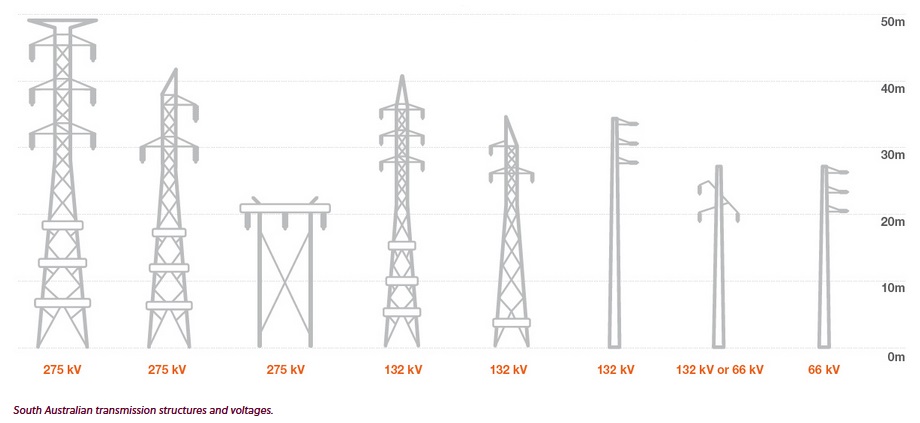
Transmission towers. (Image Source: Electranet, who got it from South Australian transmission structures and voltages.)
This means the main costs of long-distance transmission are:
- The cost of actually building it.
- The cost of capital. Either the cost of interest payments on money borrowed or — if you just happen to have a couple of billion dollars lying around — what you could have made from an alternative investment.
Less than a decade ago, the cost of capital was the largest part. But now, with interest rates at around zero, this cost has mostly disappeared. You may complain that no one’s letting you pay zero percent interest on your home loan as in Denmark, but if you are breaking ground on a giant, government-backed, billion-dollar infrastructure project in Australia, the interest you’ll have to pay is next to nothing at the moment. This has massively decreased the cost of building electricity transmission capacity, as the graph below suggests:
I used a period of 20 years in the graph above simply because it’s a length of time people can wrap their heads around. It’s not how transmission projects are paid for. They don’t just borrow money for 20 years and pay it back as a lump sum. It’s a little more complicated than that. But the graph does show how falling interest rates can massively reduce the cost of a project.
When it comes to building the infrastructure we need to shift away from fossil fuels, whether it’s long-distance electricity transmission, solar and wind farms, energy storage, or factories that spit out electric cars — the cost of building these things has never been cheaper.
Return Of High-Interest Rates Unlikely
Interest rates have been trending down for 30 years and are unlikely to return to high levels any time soon. There may be a temporary increase after COVID-19 is defeated, but I’m sure low rates will be around long term.
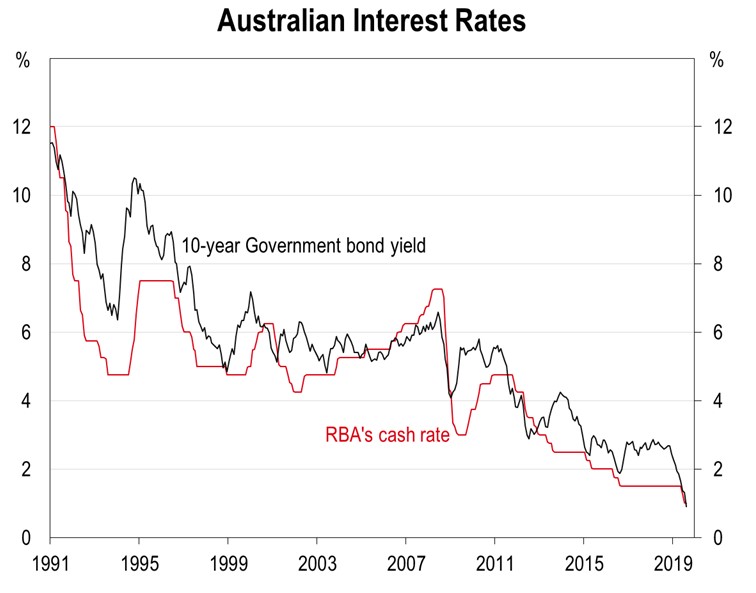
The Reserve Bank of Australia (RBA) has a cash rate that is now 0.1%. This is the rate at which they’ll lend money to large, trusted, financial institutions. The government bond rate has actually gone slightly negative. (Image Source: ABC News.)
Electricity Transmission Projects
A lot of new transmission capacity is going to be built within states. One example is the Eyre Peninsula electricity line upgrade in South Australia, which will use transmission towers stronger than those that got bent to the ground in a storm 5 years ago.
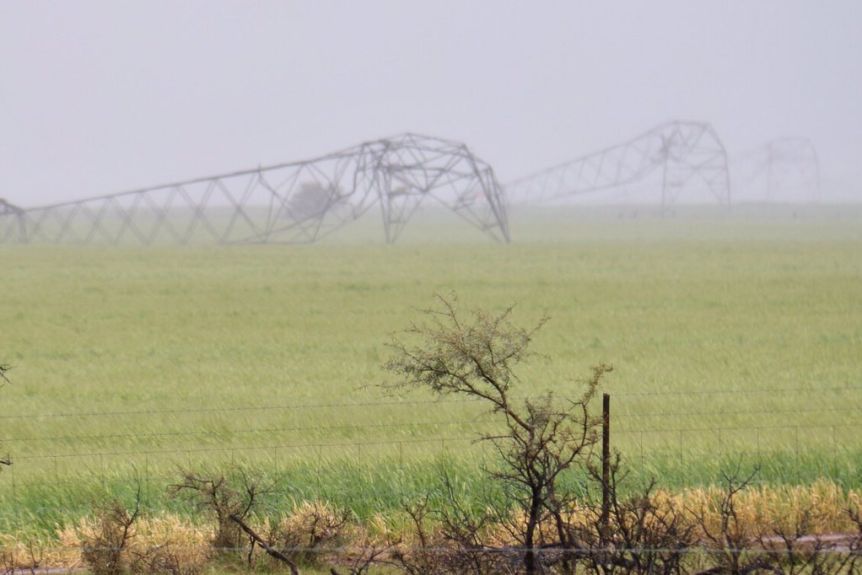
Some politicians blamed the blackout that resulted from this on renewable energy. Personally, I’m more inclined to blame powerful winds than wind power… (Image Source: ABC News and they credit Tom Fedorowytsch.)
Rather than give details of smaller projects that only cost hundreds of millions of dollars, I’ll just mention the inter-state and international ones that cost billions. Below, are a list of projects at various points of their planning process. I’ve put them in rough order of how likely they are to go ahead:
- Victoria to NSW Interconnector West (VNI West)
- Project Energy Connect Between South Australia and NSW
- Project Marinus Interconnector between Tasmania and Victoria
- The Australian-ASEAN Power Link (AAPL) by Sun Cable from the Northern Territory to Indonesia and Singapore
- Western Australia To South Australia
Victoria To NSW Interconnector West
The Victoria to NSW Interconnector West, or VNI West to its friends, is expected to provide an additional 1.8 gigawatts or so of transmission capacity between the two states. While the exact plan isn’t finalized, the estimated cost will range from $1.3 to $1.9 billion, and it may be finished by 2027.
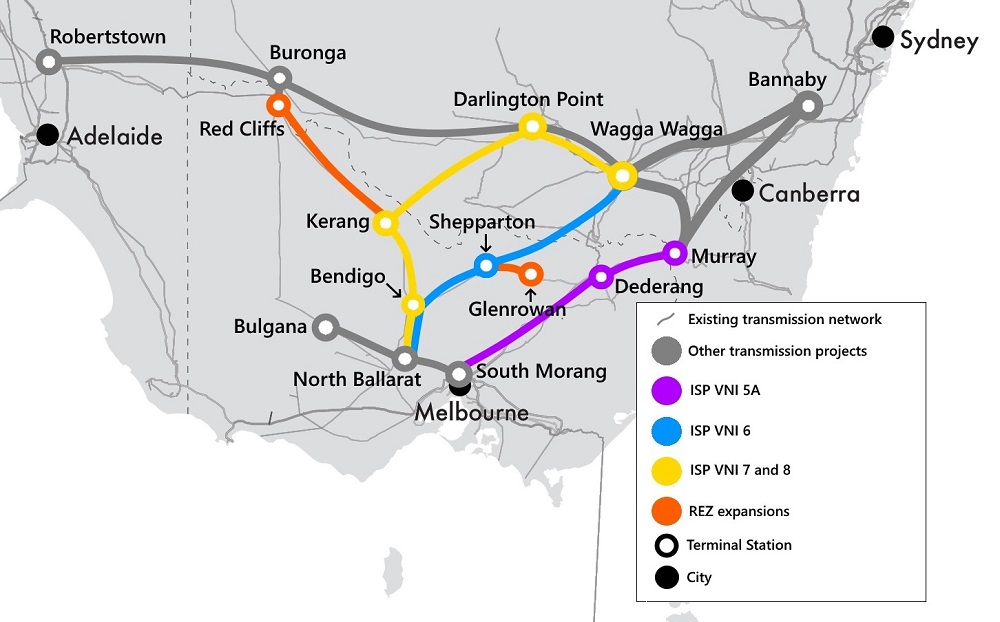
Proposed new VNI West transmission corridors. One of these coloured lines is expected to become an actual transmission line. (Image Source: AEMO)
Note that a smaller, 170-megawatt interconnector also planned between the two states is simply called VNI, so it’s easy to confuse the two.
Project Energy Connect Between SA & NSW
Project Energy Connect is a plan to build an 875 km transmission line with a capacity of around 800 megawatts between South Australia and NSW. While SA has two interconnectors with Victoria, this will be the first with NSW. It’s expected to be completed in 2023, which is quick for a large project like this.
Projections are it will lower average annual household electricity bills by around $100 in South Australia and $61 in NSW. Because there are four and a half times as many people in NSW, that state will receive the greatest total benefit. At the moment it’s not clear how many years households will have to wait before they actually see a benefit on their electricity bills. The year 2030 is one date that was thrown around recently. (Funny how this delay wasn’t mentioned around election time in SA.)
The map above was clearly made by someone with a personal connection to Wagga Wagga. I can tell this because they called it Wagga, which is a social faux pas4 unless you or your relatives live there.
The cost estimate has risen to $2.4 billion, but it still looks almost certain to go ahead — despite recent arguments over funding.
Project Marinus Interconnector Between Tasmania & Victoria
Tasmania’s only interconnector with the mainland is Basslink. The folly of having only one was revealed in 2015 when it failed during a drought that lowered hydroelectric output in the Apple Isle. The electricity supply shortfall was so bad it contributed to blackouts in the Philippines.
I know that sounds odd because there’s no Manila interconnector yet. It occurred because diesel generators were shipped from there to Tasmania because Tasmanians were willing to pay more to not sit in the dark.5
The proposed Project Marinus will consist of a 750-megawatt connection by 2028 and a second 750-megawatt interconnector by 2032. This will give Tasmania 4 times its current interstate transmission capability, and 3 separate cables mean that if one fails it won’t be a serious problem.
All the interconnectors will be HVDC, allowing Tasmania to remain out of synch with the rest of the nation. This is probably for the best, since I hear they’re so out of synch Tasmanians will soon start partying like it’s 1999.
Sun Cable — Australian-ASEAN Power Link (AAPL)
This proposed project, which may go ahead, consists of a 3,750 km underwater HVDC transmission line from the Northern Territory to Indonesia and Singapore. The plan includes a 13.1 gigawatt solar farm in the NT with 33 gigawatt-hours of battery storage. This is an ambitious project, but given the Northern Territory has better solar resources than Indonesia and Singapore, as well as enough room to build giant solar farms, then — thanks to low-interest rates — it may proceed.
WA & SA Interconnector
You may think the idea of sending an extension cord across the ocean to Asia seems far fetched. Still, I think the idea of an electricity interconnector between Western and Eastern Australia is even nuttier.
The international interconnector will have hundreds of millions of potential customers, while there are only 2.7 million West Australians. Also, instead of connecting an area of great solar resources to a not-so-great area, this will be connecting great to great.
But despite the problems, some people claim it will easily pay for itself. Provided they can convince enough other people they’re not nuttier than a lumpy chocolate bar; then we will eventually electrically connect all Australian states. Just don’t be surprised if it doesn’t happen until after we’ve plugged Japan into the end of a giant extension cord.
Alternatives To Transmission
So far I’ve written as though more long-distance transmission capacity is always a good idea. But it is possible to have too much of a good thing and there is the risk a long-distance transmission project to never provide enough benefit to be worthwhile.
Because a long-distance electricity transmission project is a long term undertaking that may require decades to pay for itself, it is possible changing conditions and improving technology could convert what looks like a sound investment now into an albino elephant that never manages to pay for itself.
While large-scale renewables and long-distance transmission currently look like inseparable buddies, if the cost of solar and/or wind farms falls far enough, it will start making sense to build less transmission capacity and start overbuilding renewable capacity. But a more serious threat is if the cost of batteries falls to a very low level. Energy storage done dirt cheap will greatly reduce the economic return from long-distance transmission.
A More Interconnectored World
Thanks to low-interest rates and the variable nature of wind and solar energy generation, we’re going to see a lot of long-distance transmission capacity construction around the world over the next 10 years. How long this boom in electricity transmission capacity continues will depend on interest rates and the cost of energy storage.
If batteries fail to fall much further in price, we may see a world where long-distance transmission has fat cables able to provide plenty of power, allowing cheap solar electricity to light up locations where the sun has set. A world of extremely cheap battery storage may still have a lot of long-distance electricity transmission, but the cables won’t be able to provide as much power as they’ll have days to redress energy imbalances between regions thanks to copious battery storage.
Personally, I’m hoping we’ll see a lot of new long-distance transmission built in the short term, as that will help us more rapidly move away from coal and gas. If falling costs of battery storage then render it uneconomic, I’d still count that as a win.
I also hope that a world where electricity interconnectors between countries are common will be a place where people feel more connected with each other. At some level, we all want to connect, and for me, it’s at the level of massive electrical cabling. I hope countries relying on each other for electricity will help us see past our petty differences, encourage us to cast aside our intolerance, and see we’re not that different from each other. We’re just one big human family — and the Dutch.
Footnotes
- I’m not counting border towns that cheat by getting electricity from a state they’re not actually in. ↩
- Or 4 if you count 4,000 km of sugar cane train gauge in Queensland. ↩
- Australia is less lumpy than Antarctica — fight me. ↩
- A faux pas is when your mother’s boyfriend moves in, and she insists you call him dad. ↩
- A system that allows rich people to pay poor people to sit in the dark is one of the triumphs of the modern world. Our grandparents got humans on the moon; we get internationally traded darkness. ↩

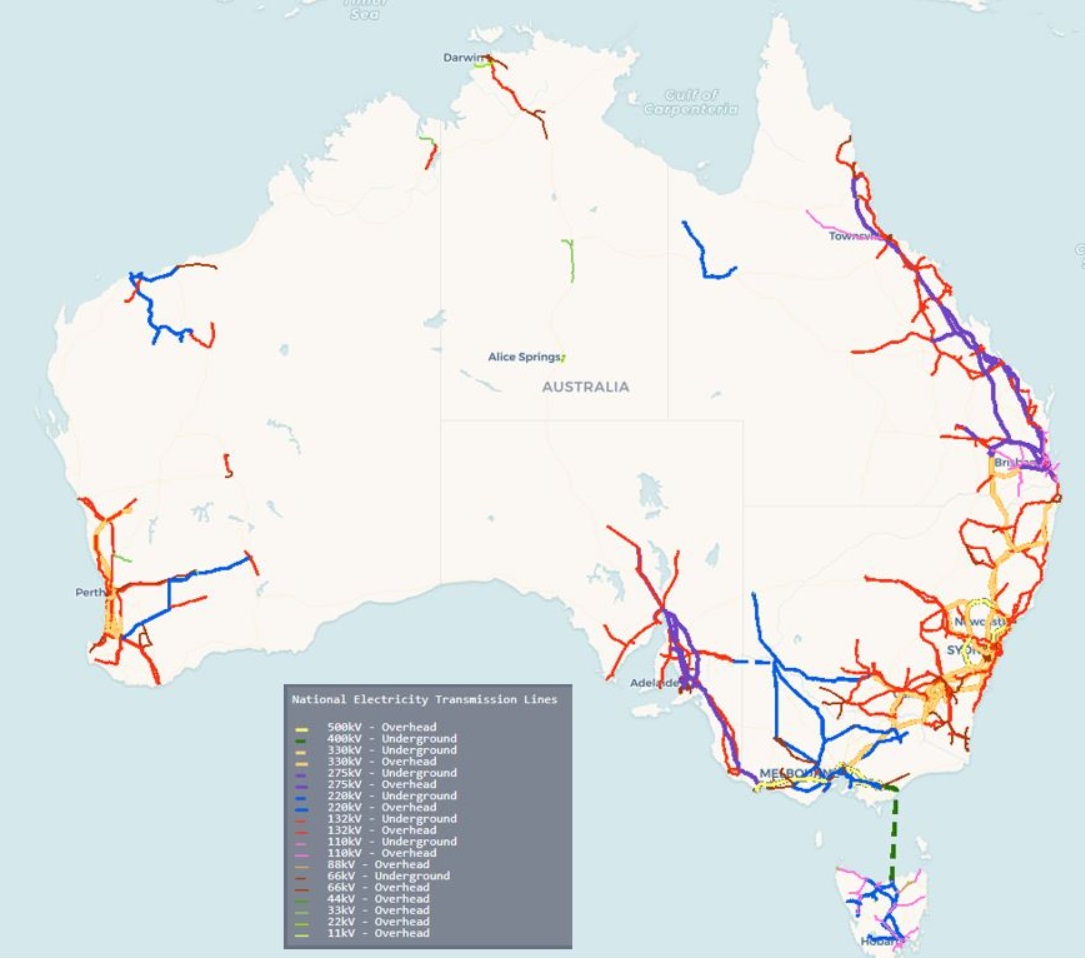
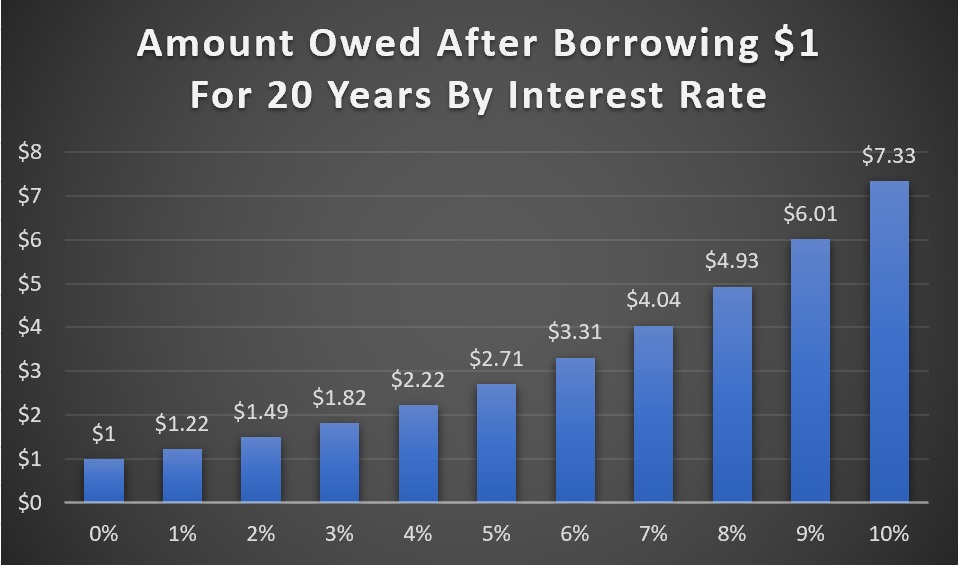
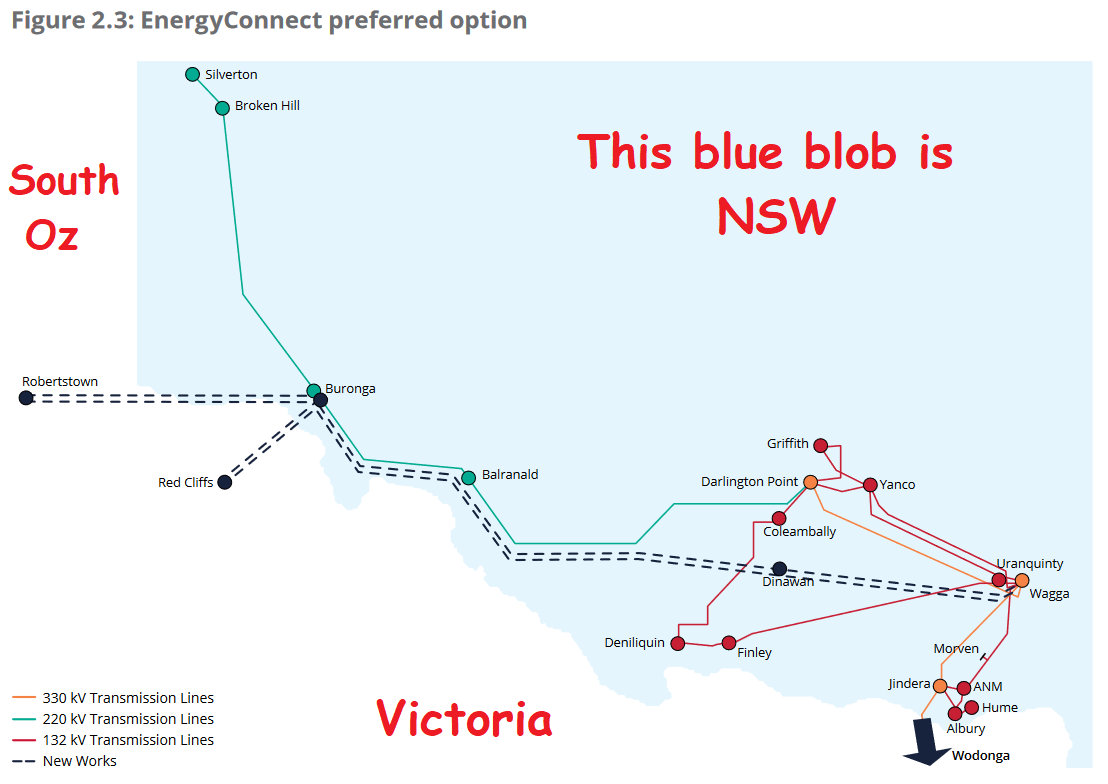
 RSS - Posts
RSS - Posts



Do network owners still get a government guaranteed return on extra investment? I recall that when the Networks were investing furiously there was talk of some hurdle rate of return they were allowed to use that was above the then market rates. My recollection is it was 12% when market rates were more like 8%. Does this ring any bells for anyone?
Hi Ronald
Again a great article – pleasing to see many of my own thoughts apparently vindicated.
One thought, though, concerns your logic regarding WA sending power to the NEM after the sun sets in NSW. Quite apart from the fact that Gladys may think Mark will turn off the switch when it suits us here in the West, the reality is that in the 2:20 hrs of extra sun we get, our rooftop solar output drops from about 20% of rated capacity, to zero – say an average of 10%. My experience is that this is not enough to provide our own requirements (around dinner time) – so unless we increase capacity by a factor of 5-10, we wouldn’t have much to export. Same in the morning in NSW. Also, I notice our wind commonly drops noticeably in the late afternoon (I used to windsurf!).
Another question – are HVDC systems bi-directional, or is a switch-over required each end when the direction of power flow reverses?
My thoughts on this, from the frozen prairies of Alberta. (It’s minus 36 C here this morning, but it’s minus 48 C ‘up north’, which is closer to the freezing point of CO2 than that of H2O. The forecast is for a sunny day, with highs approaching the temperature of a freezer, so I got out the roof rake and pulled the snow off the rooftop solar.)
I would guess it would pay to add solar PV until there’s enough juice at high noon, to run the coal power plants backwards. Since that won’t actually work, someone will use it to heat water, make ice, charge batteries, pump water, liquify air, make aluminium, process chemicals, bake bread, desalinate water. THEN talk about what to do with the surplus.
Moving electricity across a continent is crazy expensive and it’s hard to make it reliable. 99.99% reliable x 100,000 insulators is close to zero reliable. (0.9999^100000) but underground might be more secure and predictable.
Possibly you could achieve your goal of shifting the solar to evening if the transmission tower steel was made into flywheel storage at opposite ends of the country.
HVDC comes in two* flavours. Current Source Converter called ISC and Voltage Source Converter called VSC.
ISC is cheaper and the most efficient, however, the polarity must reverese to reverse power flow. Basslink is based on ISC technology.
VSC is more expensive, but more flexible. The polarity always remains the same, while the current reverses direction based on power flow. The inverters on each end can also provide grid supporting services. VSC based HVDC offers the possibility of connecting to the line at multiple places.
*a third technology called Z-source converter promises some advantages over both, but is still experimental.
Not true. Just the opposite,
Because the price of solar is falling below the cost of transmission, the best is to produce power as close to where it is used.
So if you can avoid the grid it will cheaper.
I means that even if you can produce energy free at a distance, it will be more expensive than solar generation where it is used.
Look up “God Parity”
While in principle correct, that assumes solar and any other renewable is available at that point in time to meet the demand of the local network. But is it is not, then you have to shut of users or else resort to other expensive or possibly filthy sources of power. And we know that none of those are good options.
So we make decisions on the basis of more than just seeking the cheapest option. How valuable to us is it to have a reliable power supply that is afford and consistent? To a prosperous, modern and relatively sophisticated country like Downunder, quite valuable I would say. Given the Swan drinkers want to secede anyway, perhaps we may not bother with coonecting them – unless, off course their very wealthy miners who pay little tax want to cough up for it – but there would certainly be benefits in the other propsoals.
If the sun is shining when you want the power, that is certainly true. But when you want power after sunset, transmitting it from somewhere further west is the next best.
Last time I looked, Labor still had their $20 billion, “Wiring the Nation” (or similar) policy on their website which is for Transmission
Seems like a no brainer in the new MMT world
And now I know what a Faux Pas is 😉
Being the jaded old bastard that, only 68 years can manufacture . I @m incredulous to the fact that knowing how disingenuous government attempts at lowering power prices. Frankly it is not in the government’s interest to lose taxation by producing cheaper power and the reduction of fossil fuel revenue by going “alternative” power production. Just look at the “Death Grip” on gas and oil revenues.
Once again the only reason prices may have dropped a modicum, is because demand has dropped, thanks to Covid.
Well the wind blows a lot more in the West so when that Fremantle doctor kicks in it could supply power.
In answer to your question about HVDC it’s quite simple – the current flows in the direction of the lowest voltage potential. So it depends where the demand is. You can parallel demands at both ends, so as long as there’s enough power being generated you can run inverters at both ends to feed the grid. Conceptually think of it this way – if I have a giant battery or DC generator, I can run an inverter in my house but I could also run an inverter in my friends house if I had a long enough cable and my battery was high enough voltage to avoid substantial losses in the cable.
Could a nation wide HVDC act like a ring connection through your neighborhood – if each house had solar and a battery, any house could add or take energy as needed with only q small impact on other households.
Maybe that’s not as relevant for Australia if there is little load or supply in the middle, to buffer the system.
It could but it at current costs it is far cheaper to build about 20-30% more generation near the load and store/spill the excess.
DC links have a place eg Europe to the UK and maybe even NT to Singapore or Japan to Korea but the huge enthusiasm for DC links a few years ago has died down because the cost of generation now is often less than the cost of transmission over more than 300-500km.
The other problem is that DC links are not very reliable. The Scotland to Wales link was down 70% of the time in 2017. When Basslink goes down it has been offline for months whereas even major failures in aerial AC lines in Victoria and SA have been temporarily reinstated in 10 days or so
Hm-mm – I do understand dc circuits quite well – but you seem to be saying that inverters can carry power in both directions?
I know a transformer can do this – but I can say with some certainty, that my inverter works only in one direction. It takes dc power in, and produces ac out. To go the other way, you need something like a HV battery charger.
Perhaps you could wire then back-to-back – but I’d think you’d need some pretty smart change-over switching system to avoid serious circulating currents.
And this may need to be synchronised at each end of a 3,000 km long cable?
The undersea HVDC interconnects between Great Britain and Europe do are bidirectional.
I don’t know the technical details, i’d guess they have both rectification and inverter equipment at both ends.
It would seem to me that it would be more likely worthwhile making the connections across the country if there’s enough demand / supply along the line to partially pay the cost. But I don’t know whether HVDC systems can work with multiple, simultaneous power supplies and loads.
The point is that while Mark P1950 is simplifying things a bit, most of these transmission projects are unnecessary and uneconomic. According to Tesla, a three hour battery is US$200,000 per MWh and including electronics etc $US 900,000 per MW, but they also aim to reduce the cost of batteries by 50% over the next three years. So lets say in three years time SA decides to install 800 MW of distributed batteries to provide the same level of FCAS and power system security. Even with only a 33% reduction in costs the batteries would cost $650m.
However at the moment SA only needs 250MW of spinning reserves and it is installing more batteries and four synchronous converters and continuing to expand its VPPs and AGL is proposing to install a 250 MW battery so SA has plenty of energy security already, so why pay a dollar for more. It has hardly even started with controlled demand and synthetic inertia which are much cheaper again than batteries or new transmission
Currently SA has enough interconnector capacity to export a conservative average 500MW but it is actually only exporting an average 130 MW so any new interconnector will initially carry very little energy, particularly as it will have to charge higher carriage fees than the existing written down assets via Victoria.
NSW is building renewables faster than it is closing FF plants so its imports have declined from more than 7.3TWh in 16/17 to tracking less than less than 5.3TWh this financial year. In the meantime upgrades to existing links to Queensland and Victoria will provide more import capacity than it needs.
Just completing the already financed new wind and solar plants on the Clean Energy Council list and continuing its current 70 MW/month of behind the meter generation will mean that in three years time NSW will generate enough new renewables to replace Liddell and all its existing imports
As is obvious NSW exports very little power and will naturally sell most of what it does export to closer markets such as Victoria and SE Queensland even if average prices were similar. But now SA has the lowest average spot prices on the grid and NSW the highest so how much water (electricity) is going to flow up hill price wise.
The current interconnectors operate at a cumulative 23% capacity. This line will slightly more than double capacity and it will often be the third choice for exports so if for the first few years it runs at 10% capacity it will be extremely lucky.
At a weighted cost of capital of 5% and a 40 year financing period it has to earn $156 million per year to cover finance and depreciation, Even at very low utilisation it will still have losses about 1% of rated capacity in iron losses and other energisation loads plus impedance losses when it is actually working. At $40/MWh that is another $3m, maintenance including vegetation control at a very low 1.5% of capital value and administration and general expenses including insurance and compliance costs of 2% of capital value brings operating costs to $80-100m per year. i.e a breakeven revenue of $250m/y.
If it is operating at 10% of capacity that is 700,000 MWh per year transferred in both directions. That works out at a breakeven revenue of $356/MWh transmitted.
Who exactly will be prepared to pay that ????.
One can do similar calculations for Marinus Link and all the other long distance transmission and all of it proves to be uneconomic. About the only one that seems to make sense and that is only due to a post facto rescue of uneconomic generation in western Victoria is the Bulganna South Morang link
“NSW is building renewables faster than it is closing FF plants”.
But are they renewables that can supply during the evening peak of demand? It is not just about total energy transmitted, but also about the intermittent nature of renewables. A wide spread, well connected renewable system will require less stored energy and / or fossil fuelled backup.
“The current interconnectors operate at a cumulative 23% capacity.”
Average or peak? Batteries similarly provide low current most of the time, but it is the peak power that keeps the system stable.
David
Of course it is complicated, but in fact peak demand periods are quite short so three hours of battery storage will take care of most peak demand events. At current costs, 800MW three hours of battery storage in NSW would cost about A$1b.
SA is already running at 70% renwables and has a large excess of generation capacity so it doesn’t need any more transmission for FCAS purposes. Thus it will probably only invest no more than $600-700 m in new grid storage and even that will be spread over the years as prices fall,
So combined – sufficient storage to provide equivalent grid stability and peak capacity to both grids will cost about half the cost of Energy Connect.
In addition NSW is upgrading capacity from Qld and Victoria.
NSW will also be the beneficiary of Snowy II another hugely wasteful expenditure but it is probably too late to stop it.
Then while wind and solar can be well below rated capacity, peak demand in NSW always occurs on hot windy afternoons, where minimum wind and solar are at least 15% of combined nameplate capacity and sometimes 65%. As NSW adds 5GW of renewables over the next 3 years minimum wind and solar at peak demand will increase by 400-600 MW
So NSW will have about 400 MW from enhanced transmission, 400 MW extra renewables, 2,000 MW from Snowy II, probably 600 MW of new demand response and anywhere between 400 and 3,000 MW of new batteries. In terms of despatchable capacity that is Liddell and Bayswater combined. So Assuming Snowy II is completed, NSW can close 8 of its 16 coal units over the next six years with no loss of security or energy supply
Hi Folks,
Thanks for sharing the knowledge so far, but regarding “transmission vs local” I have not noticed any reference to Fuelling TRANSPORT.
EV trucking appears to be working towards swappable battery packs at strategic points so if all of these charging stations are stand-alone – imagine one at Meekatharra – what happens on a cloudy windless day?
Ditto with freight trains (at least they run on a conductor), or ships, or planes to a lesser extent… so a national HVDC ring main with inputs from Solar, wind, wave, hydro wherever it can be harvested and using pumped hydro as well as batteries to smooth and store to provide continuity 24/7 seems to make sense.
Although there is an alternative that I have not seen mentioned yet… what about a geo stationary mirror to reflect sunlight on to the key solar farms or cities even (save on street lighting for one thing), but seriously, in another blog the question of recycling solar panels and e-waste in general has also to be factored into the generation vs transmission debate, the same issues apply in the manufacture/grow vs consumption debate. Local is best but not always possible.
Keep up the good work, and thanks again.
Periods of low solar and wind out put will be dealt with through…
1. Overbuilding — there will be extra, low cost, renewable capacity.
2. Geographical dispersion – The wind can be strong in north Queensland while it’s calm to the south. Same for solar.
3. Releasing water in hydroelectric dams and firing up gas generators. (Gas generators can be replaced in the future.)
An off-grid charging station will likely overbuild solar a lot and can also use generators. These places generally don’t have a lot of cloudy weather, so generator use can be kept to a minimum.
Note that trucks that aren’t carrying perishables can slow down or spend more time off the road if electricity prices go up due to low renewable output.